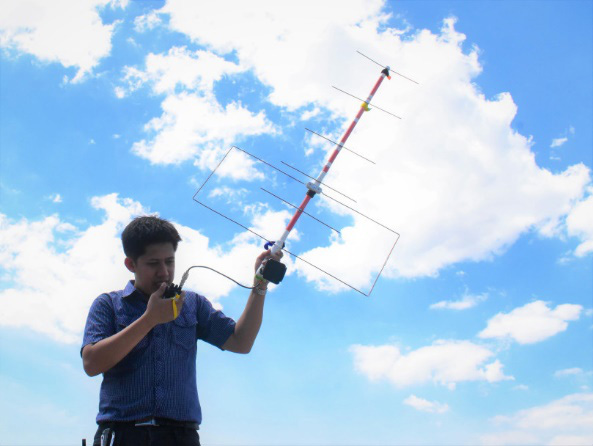By using amateur radio satellites as voice repeater, it is possible to contact fellow satellite operators in nearby countries (such as Japan, Malaysia, Singapore, China, Indonesia, and anywhere in the Philippines) using any VHF-UHF-capable transceiver. This article describes how to access some of the amateur radio satellites such as Diwata 2 (PO-101), AO-91, AO-92, IO-86, and SO-50.
During the recent District 1 Pakulo 2019, a local hamfest held in Tagaytay on May 11, 2019, I've conducted a live demo of a satellite QSO. From my QTH in Tagaytay, I've worked with the following stations during the AO-91 pass: JS6DRQ, DU6DKL, DU2XXA, DU4PGS, 7J1ADJ/JR6, and JA6PL. The demo showcased a satellite repeater's capability to relay signals and enable two-way communications to any point in the Philippines, as well as nearby countries, using inexpensive ham radio equipment.
Without a clear line-of-sight, a typical VHF-UHF radio equipment with 5W of output power (such as a handheld transceiver) can only reach up to about 3 to 5 km. In an open area where there is a clear signal path between transceivers, the range can easily reach up to 30 to 50 km. To further increase the range, relay stations are used to re-transmit the signal (to another frequency), using a device called a repeater.
A well-placed repeater significantly extends the communication range of a radio equipment. Your signal can be picked up by the repeater and re-transmit it to up to a distance of hundreds of kilometers. Due to high elevation, repeaters installed in mountain peaks allow communication to up to 200 km or perhaps even farther. As you install a repeater in higher locations, the range significantly increase. Baguio, for example, is only 1.4 km above sea level, and yet repeaters placed on its summit are one of the best performing ones. Now imagine placing that repeater in space, at a height of 400 to 600 km! Your handheld transceiver’s could easily reach any point in the country and the whole of South East Asia!
Other than capturing photos and monitoring conditions in space, satellites can also be equipped with a repeater module! Satellites with an on-board amateur radio equipment are referred to as Orbiting Satellites Carrying Amateur Radio (OSCAR). The first orbiting repeater called OSCAR 1 was launched in 1960 (just 4 years after the first satellite, Sputnik). Recently, the Philippines has built and launched Diwata 2, its first microsatellite with amateur radio equipment on board, designated as Philippines OSCAR-101 (PO-101).
Satellite repeaters are no different to a regular terrestrial repeater used by your ham radio group, except that they are in space! Like any other repeater, there is a pair of frequency to use: one for transmitting (TX) and one for receiving (RX). In satellite repeaters, the TX frequency is called the uplink, while the RX frequency is called the downlink. Most satellite repeaters require an inaudible access tone played at the beginning of a transmission (it acts like a pass key). Only transmissions carrying the correct access tone will be picked up and relayed by the satellite repeater. This helps prevent the satellite from “repeating” unintended transmissions on its uplink frequency.

Using an FT60 and a DIY antenna to access satellite repeaters
There are a number of satellites that are accessible to anyone with an amateur radio license. The easiest satellites are the following, with corresponding info on uplink and downlink frequencies, as well as the required tone for repeater access.

With a VHF-UHF capable transceiver, key in the correct uplink and downlink frequencies, as well as the correct tone. Wait for a satellite to pass in your vicinity (consult this page). As the satellite reaches its closest approach, you may now hear its downlink signal. Listen first to check activity, then transmit and state your call sign. If successful, other stations monitoring the satellites will likely hear and answer your call. You may have a 2-3 minutes of successful contact, and with an upgraded antenna and radio equipment, it can last up to 10 minutes. Expect to hear foreign call signs (Japan, Malaysia, China, Singapore, Indonesia, etc.)
Any portable radio will work, especially for overhead passes, but in order to improve signal transmission and reception, external antennas must be used. You can use any antenna, but the ones that work best are the directional types (Yagi-Uda for example). To view the antenna I use to communicate via satellites, head directly to My Satellite Antenna.
Here’s a demonstration on how I used an FT60 with 5W of power to access Diwata 2 satellite during its testing phase. In the video, I have successfully made contact with stations in Pangasinan and in Okinawa, Japan, from Sta. Rosa, Laguna. Notice how I tracked the satellite using a home-brewed antenna.
Satellite communications continue to be an exciting hobby. I hope this overview has inspired you to give it a try and learn another way of enjoying amateur radio! In my future posts, I will discuss in detail how to build a simple satellite antenna to greatly increase your chances of accessing the satellites.
For more information about satellite communications, head directly to my website at: https://nightskyinfocus.com/